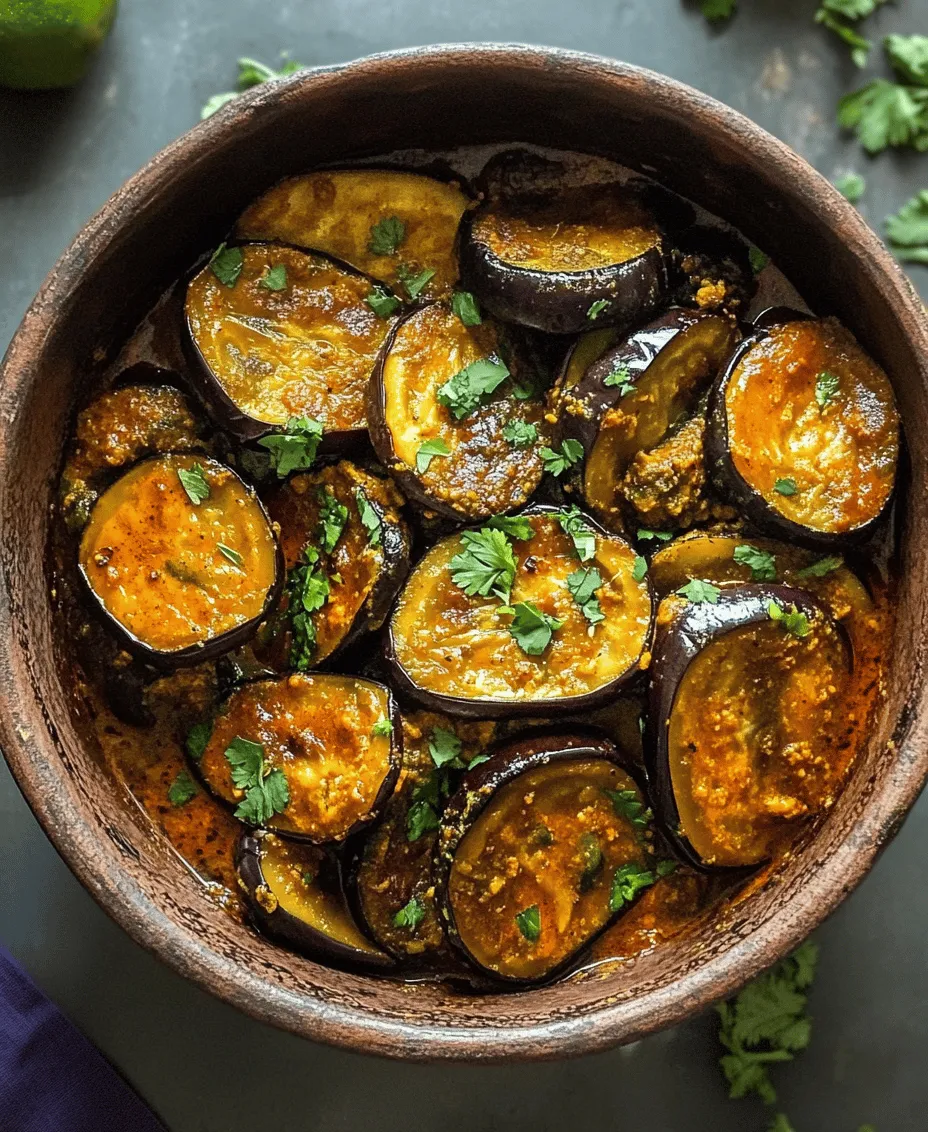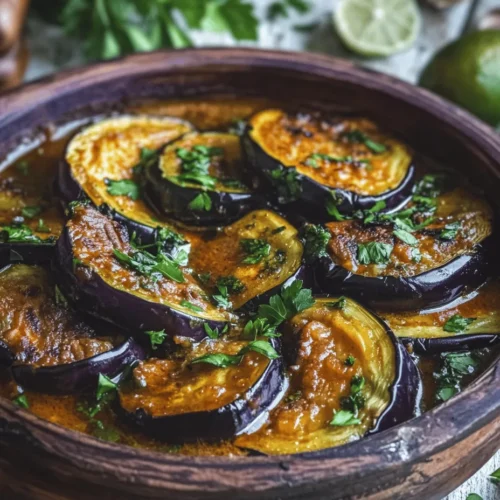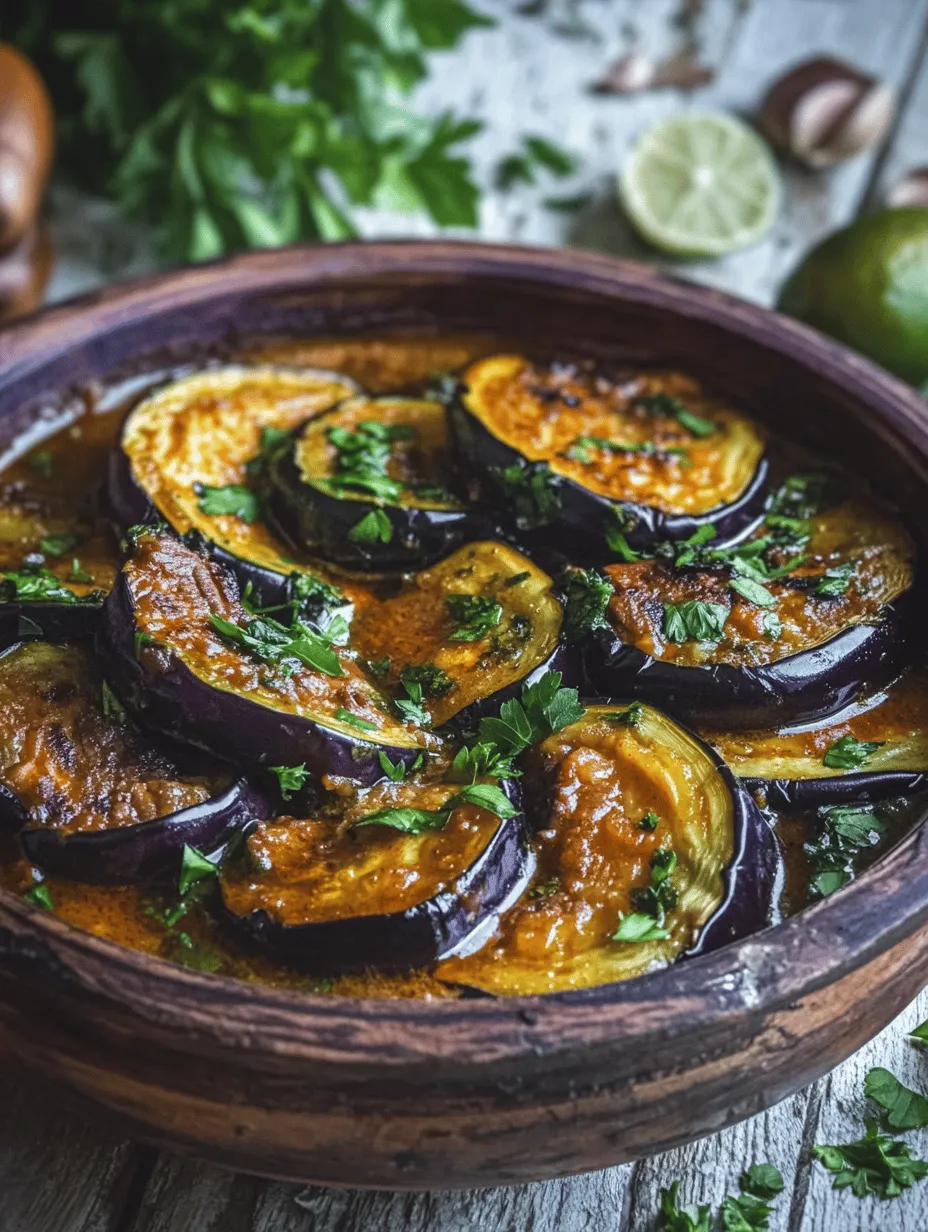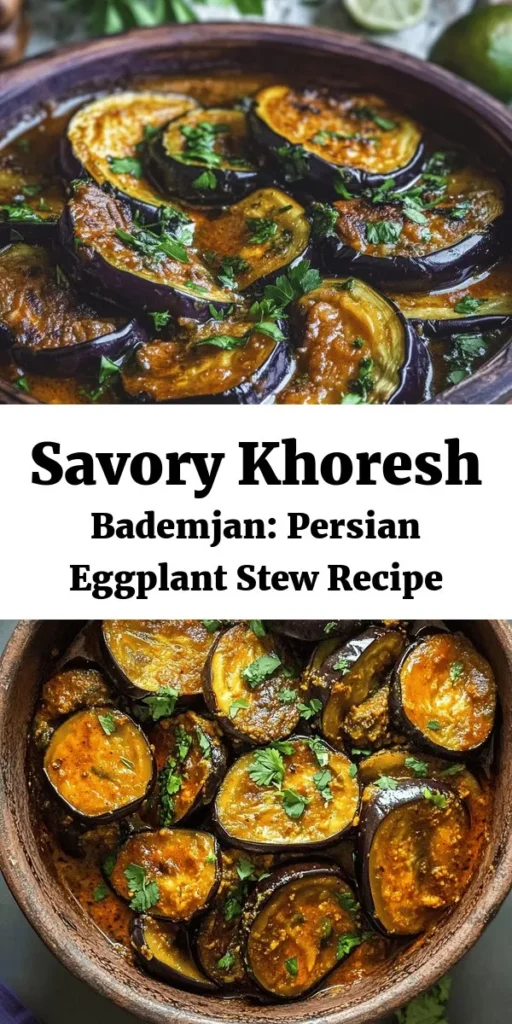Introduction
Khoresh Bademjan, often referred to as Iranian eggplant stew, is a cherished dish in Persian cuisine that captures the essence of home-cooked comfort. This richly flavored stew, with its fragrant blend of spices and tender eggplants, showcases why Persian cooking holds a significant place in the world of gastronomy. The dish is not only a staple during family gatherings and celebrations but also serves as a reminder of the warmth and hospitality that characterizes Iranian culture.
Eggplants, or “bademjan” as they are known in Persian, play a central role in Khoresh Bademjan and are revered in many Iranian dishes. Their creamy texture and ability to absorb flavors make them an ideal candidate for stews and casseroles. Beyond their culinary appeal, eggplants are a symbol of abundance and are celebrated in various regional dishes across Iran, with a multitude of preparations highlighting their versatility.
Khoresh Bademjan can be customized to fit various dietary preferences, including vegetarian and vegan options. While traditional recipes often feature tender chunks of beef or lamb, many modern adaptations emphasize the use of plant-based proteins, making this dish accessible to a broader audience. Whichever variation you choose, the dish’s rich flavors, comforting qualities, and inviting aroma are sure to delight anyone who tries it.
Understanding Khoresh Bademjan
The term “Khoresh” translates to “stew” in Persian, and it encompasses a diverse range of dishes that are usually served with rice. Khoresh Bademjan stands out due to its unique combination of eggplants, meat (optional), and a variety of spices that create a complex flavor profile. This dish is not merely a meal; it is an experience steeped in tradition, reflecting the rich history of Persian culinary arts.
Historically, Khoresh Bademjan has its roots in the Iranian plateau, where the fertile soil and favorable climate allow for the growth of a variety of vegetables, including eggplants and tomatoes. These ingredients have been staples in Persian cooking for centuries, and their presence in Khoresh Bademjan symbolizes the harmony of flavors that Persian cuisine is known for. The dish is particularly popular in the colder months, providing a warm and hearty option for family gatherings or cozy dinners.
Ingredient Breakdown
To create a delightful Khoresh Bademjan, understanding each ingredient’s role is essential. Here is a detailed description of the key components:
– Eggplants: The star of the dish, eggplants, come in various types. For Khoresh Bademjan, the globe variety or Persian eggplants are ideal due to their tender flesh and fewer seeds. When selecting eggplants, look for ones that are firm and shiny with a deep purple color. Avoid those with blemishes or soft spots, as they may be overripe.
– Vegetable Oil: This ingredient is crucial for frying the eggplants and enhancing the overall flavor of the stew. A neutral oil, such as canola or sunflower oil, is preferred, as it allows the flavors of the spices and vegetables to shine through without overpowering them.
– Onions and Garlic: These aromatic ingredients form the base of the stew. Onions provide sweetness and depth, while garlic adds a pungent, savory note that elevates the dish’s flavor profile. Finely chopping or mincing these ingredients ensures they meld beautifully into the stew.
– Beef or Lamb: While traditional Khoresh Bademjan often includes chunks of beef or lamb, you can substitute with plant-based proteins like chickpeas or lentils for a vegetarian version. If using meat, opt for cuts that become tender during cooking, such as chuck or shoulder.
– Tomatoes: Fresh tomatoes can be used in the dish, but canned tomatoes are a convenient option that provides consistent flavor and texture. They add acidity and sweetness, balancing the richness of the eggplants and meat.
– Spices: The heart of Khoresh Bademjan lies in its spices. Turmeric, cumin, and cinnamon are commonly used to create a warm, aromatic profile. Turmeric provides a beautiful golden hue, cumin offers an earthy note, and cinnamon introduces a subtle sweetness that rounds out the flavors.
– Dried Limes: These unique ingredients are a hallmark of Persian cooking. Dried limes, or “limoo omani,” add a tangy, slightly bitter flavor that enhances the stew’s complexity. If unavailable, you can substitute with fresh lime juice, though the flavor won’t be as intense.
– Fresh Parsley: This herb serves as both a garnish and a flavor enhancer. Chopped parsley sprinkled on top of the stew adds a fresh, vibrant note that contrasts beautifully with the cooked ingredients.
Preparation Steps
Preparing Khoresh Bademjan involves several key steps to ensure the eggplants are perfectly cooked and the flavors meld together harmoniously. Here’s a detailed guide to the first stages of preparation:
Preparing the Eggplants
Eggplants can have a spongy texture, which can absorb a lot of oil during frying. To mitigate this, salting the eggplants before cooking is essential. This process draws out excess moisture and bitterness, enhancing their texture and flavor.
1. Slice the Eggplants: Begin by washing the eggplants thoroughly. Cut off the tops and then slice them lengthwise into ½-inch thick strips. Depending on your preference, you can choose to cut them into rounds or cubes.
2. Salt the Eggplants: Generously sprinkle salt over the sliced eggplants, ensuring that each piece is well-coated. The salt will draw out moisture and bitterness, allowing for a better texture once cooked.
3. Let Them Rest: Allow the salted eggplants to sit for about 30 minutes. You will notice beads of moisture forming on the surface, indicating that the salt is doing its job.
4. Rinse and Dry: After resting, rinse the eggplants under cold water to remove the excess salt. Pat them dry with a clean kitchen towel or paper towels to absorb any remaining moisture. This step is crucial to ensure the eggplants fry well and do not become soggy.
Frying the Eggplants
Frying the eggplants is a pivotal step that contributes to their flavor and texture in the stew. Here are tips to achieve the perfect golden-brown color:
1. Heat the Oil: In a large, heavy-bottomed skillet or frying pan, heat a generous amount of vegetable oil over medium-high heat. You want enough oil to submerge the eggplants partially, as this will help them cook evenly.
2. Fry in Batches: To avoid overcrowding the pan, fry the eggplants in batches. Carefully add a few slices to the hot oil, ensuring they are not touching. Fry for about 3-4 minutes per side or until they achieve a deep golden color.
3. Drain Excess Oil: Once fried, transfer the eggplants to a plate lined with paper towels to absorb any excess oil. This step ensures that your Khoresh Bademjan is not greasy and allows the eggplants to retain their shape and flavor.
4. Repeat: Continue frying the remaining eggplant slices in batches until all are cooked. Set them aside while you prepare the rest of the ingredients for the stew.
With the eggplants prepared, you are now ready to move on to the next stages of creating this delightful Khoresh Bademjan. This dish embodies the heart of Persian cooking, where each ingredient plays a vital role in crafting a meal that is as nourishing as it is delicious. Stay tuned for the next steps in this culinary journey that promise to bring the flavors of Iran to your kitchen!

Sautéing Onions and Garlic
To begin crafting the rich flavors of Khoresh Bademjan, start by sautéing the onions and garlic. Heat a generous amount of oil in a large pot over medium heat. Once the oil is shimmering, add the finely chopped onions. The key to achieving optimal flavor release is to sauté the onions slowly, allowing them to caramelize and develop a golden color. This process typically takes about 10 to 15 minutes. Stir occasionally to ensure even cooking and prevent burning.
Once the onions are translucent and slightly browned, add the minced garlic. Garlic cooks faster than onions, so it only needs about 1 to 2 minutes to become fragrant. This step is crucial as it forms the aromatic base for the Khoresh Bademjan, setting the stage for the other ingredients to mingle and create a symphony of flavors.
Browning the Meat (if using)
If you choose to include meat in your Khoresh Bademjan, this is the perfect time to brown it. Add your choice of meat—lamb, beef, or chicken—into the pot with the sautéed onions and garlic. The browning process is vital for developing depth of flavor; it caramelizes the natural sugars in the meat, creating a savory crust. Sear the meat on all sides for about 5 to 7 minutes until it’s nicely browned.
Season the meat generously with salt and pepper during this stage to enhance its flavor. You can also add spices like turmeric or cumin at this point, allowing them to toast slightly in the oil and infuse their flavors into the meat. This technique not only elevates the taste but also adds a beautiful aroma to your kitchen.
Combining Ingredients
Once the meat is browned, it’s time to layer the flavors effectively. Add chopped tomatoes or tomato paste to the pot, stirring well to combine. This addition introduces acidity, balancing the richness of the meat and onions. Next, pour in the water or broth until the meat is just submerged. This liquid will aid in simmering the dish and extracting the flavors of all ingredients.
For a more complex flavor profile, consider adding spices such as cinnamon, allspice, or cardamom. These warm spices are traditional in Persian cooking and will elevate the dish to new heights. Once all the ingredients are well combined, bring the pot to a gentle simmer.
Simmering the Dish
Simmering is a critical stage in the preparation of Khoresh Bademjan. Cover the pot and reduce the heat to low, allowing the dish to cook slowly. This slow cooking process is essential for tenderizing the meat and allowing the flavors to meld beautifully. For meat versions, let the dish simmer for about 1.5 to 2 hours, or until the meat is tender and easily falls apart.
For vegetarian versions, you’ll want to adjust your cooking time. If using lentils or chickpeas instead of meat, aim for about 30 to 40 minutes of simmering. This shorter cooking time is sufficient for the legumes to soften without losing their shape or texture.
Adding the Eggplants
While the stew simmers, prepare the eggplants. Traditionally, eggplants are cut into thick slices or cubes and fried until golden brown. This technique not only enhances their flavor but also helps maintain their texture when added to the stew. To prevent bitterness, you may choose to sprinkle salt on the eggplant slices and let them sit for about 30 minutes before rinsing and drying them.
Once the eggplants are ready and the stew has simmered, gently fold the fried eggplants into the pot. Be careful not to stir too vigorously to avoid breaking them apart. Allow the Khoresh Bademjan to simmer for an additional 30 minutes. This final simmering will help the eggplants absorb the stew’s flavors, resulting in a cohesive and delicious dish.
Serving Suggestions
Khoresh Bademjan is typically served with a generous portion of basmati rice or Persian pilaf. The fluffy grains of rice complement the rich stew beautifully, allowing the flavors to shine without overwhelming the palate. For an appealing presentation, mound the rice on a large platter and carefully spoon the Khoresh Bademjan over it. Garnish with fresh herbs like parsley or cilantro for a pop of color.
In Persian culture, Khoresh Bademjan holds a special significance during family gatherings and celebrations. The communal aspect of sharing a large dish fosters connection and warmth among loved ones. It’s often accompanied by side dishes such as fresh salad Shirazi, pickles, and yogurt, which provide refreshing contrasts to the rich stew.
Nutritional Information
Khoresh Bademjan not only delights the taste buds but also offers numerous health benefits. Eggplants, the star ingredient, are rich in fiber, vitamins, and antioxidants, making them a heart-healthy choice. They are low in calories, which can aid in weight management while providing essential nutrients.
The spices used in Khoresh Bademjan, like turmeric and cinnamon, have anti-inflammatory properties and can contribute to overall health. If you’re looking to make the dish healthier, consider reducing the amount of oil used for frying the eggplants or opting for lean cuts of meat. Additionally, you can add more vegetables like bell peppers or carrots to increase the nutritional profile without compromising the flavor.
Conclusion
Khoresh Bademjan is more than just a dish; it is a comforting and flavorful experience that embodies the essence of Persian cuisine. Its rich tapestry of flavors, from the caramelized onions to the tender eggplants and aromatic spices, makes it a delightful meal for any occasion. Whether you’re cooking for a special family gathering or simply seeking a comforting weeknight dinner, this Persian stew is sure to impress.
I encourage you to try making Khoresh Bademjan at home. With its vibrant colors and rich flavors, it’s bound to become a treasured addition to your culinary repertoire. This dish, with its deep-rooted cultural significance and heartwarming flavors, is perfect for bringing family and friends together around the dining table. Enjoy the process of creating this traditional dish, and savor each bite as you celebrate the art of Persian cooking.



